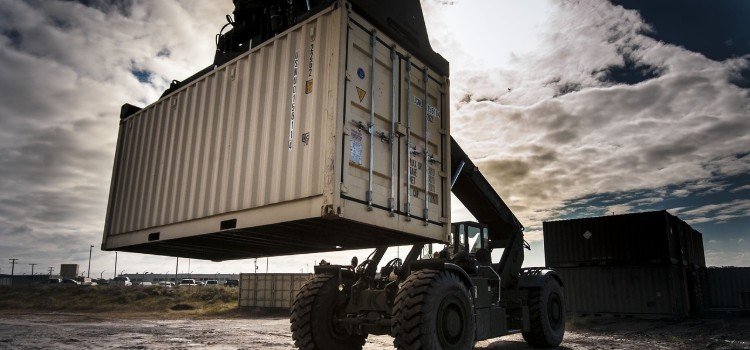
One advantage of working with a dedicated team of experienced freight forwarders is the reduction of surprise freight destination charges.
Importers who are booking with steamship lines directly should take extra care to ask questions about their quotes and the possible charges that could appear down the line.
BAF and Base Ocean Freight Charges
Two basic surcharges that may be applicable are the base ocean freight, also known as the base rate, and the bunker fuel surcharge. These are the largest ocean freight destination charges included in a rate.
The bunker adjustment factor (BAF) is a fuel surcharge that changes quarterly according to the steamship line. This particular rate is closely tied to oil prices. The rates are posted quarterly on January 1, April 1, July 1, and October 1 of each year, and may go up or down.
Transit time is one of the main factors in determining BAF charges. For example, a shipment going from Amsterdam to New York will have a lower BAF charge than one going from Amsterdam through the Panama Canal to Los Angeles. This is because it spends fewer days in transit.
Different steamship lines may use varying BAF formulas, but here are the four most common components used for calculation:
- Total fuel consumption
- Days in transit
- Vessel capacity
- Utilization factor
Other standard charges include the currency adjustment factor (CAF), when a shipper pays local ocean freight in a currency that is subject to fluctuations. As well as the emergency bunker charge (EBAF). The CAF charge is less common because in Asia they use U.S. dollars for ocean freight charges. However, in Europe shippers may still see a CAF charge.
EBAF charges appear when oil prices drastically increase. When the quarterly rates change, shippers may see this surcharge. According to FMC regulation, steamship lines are not allowed to raise surcharges on short notice. They can only do so after giving a minimum of 30 days’ notice. EBAF charges come and go, but they are never a surprise because of this communication requirement.
While BAF charges may be included with ocean freight charges when shipping out of Asia, importers often see separate charges for ocean freight and BAF when shipping from Europe to the United States.

Port Congestion Surcharge
When a port is particularly busy, the steamship line may add a few hundred dollars to the destination charges and label them port congestion surcharges (PCS). These charges frequently change which can make it hard for importers to anticipate them. Like other surcharges, steamship lines are required to include a notice of this potential charge in their rules.
For example, if an importer frequently ships through Montreal and that port becomes particularly busy, they may receive a bill stating that there is now a $300 PCS.
Destination Terminal Handling
A container arrives at the port of origin by truck. A crane then moves it to a container stack, and then onto a ship. At its destination port a crane removes the container from the boat, and puts it on a container stack. It must then be loaded onto another truck to complete its journey to the final destination. Destination terminal handling is the name they give to the crane work.
Importers may be confused when they see this charge because not every steamship includes it with the quote, so it could be an unwelcome surprise. Destination terminal handling can be between $250-$800 for a single container, depending on how the steamship line formats their bill. Importers need to be aware of these potential costs so they can ask the right questions.
It comes down to factoring all transportation costs and timelines for your shipments. If you are not in a major metropolitan area, you will be paying extensively for drayage. As much as possible, and when available, consider rail rates to get your shipment as close to its destination as possible. Advanced planning will also go a long way to thwarting unexpected routing delays.
Peak Season Surcharge and General Rate Increase
Even though importers are entitled to a 30-day notice of price increases and rate changes, they don’t always have time to change their game plan when rates go up. Peak season surcharge (PSS) may apply when container volume goes up. General rate increases (GRI) are part of regular shipping costs. The steamship lines raise prices but then decrease them based on supply and demand. They are legally allowed to raise prices up to the amount listed in their previous announcement. These two charges introduce a great deal of uncertainty for importers. Even though they have the advantage of fixed rates that run from May 1st to April 30th, supply and demand can drive PSS and GRI costs that result in a rate increase every two weeks.
LCL Surcharges
When shipping LCL, it’s crucial for importers to take into consideration the various surcharges that could have a substantial impact on their final bill. Getting a great rate on ocean freight is important, but additional costs like terminal handling fees prices per cubic meter, forklift fees, and CFS fees make the rate less attractive. There aren’t regulations for LCL shipping regarding price changes like there are for full shipping containers.
Importers should verify that the quoted price includes BAF and terminal handling on both sides. These are some of the biggest billing problems importers experience. Be aware of EBAF and port congestion surcharges, as well. While steamship lines are required by law to give importers a minimum of 30 days notice when rates change, it’s possible to miss the memo and end up with a surprise charge.
It’s also important to consider charges that could be specific to a particular destination. For example, Los Angeles is a chronically congested port, so to discourage shippers from picking up their containers during the day, there’s an extra $180 charge to do so. Picking up during non-peak hours allows the importer to avoid that extra cost.
A good freight forwarding company can help manage freight destination charges and confirm that the importer understands exactly how much it will cost them to get their container from point A to point B. A carrier can take advantage of a shipper by tacking on extra charges and requiring the importer to pay upfront before they release the container. This gets especially tricky when the importer only has four to five days to pick up their goods before it goes to demurrage.




